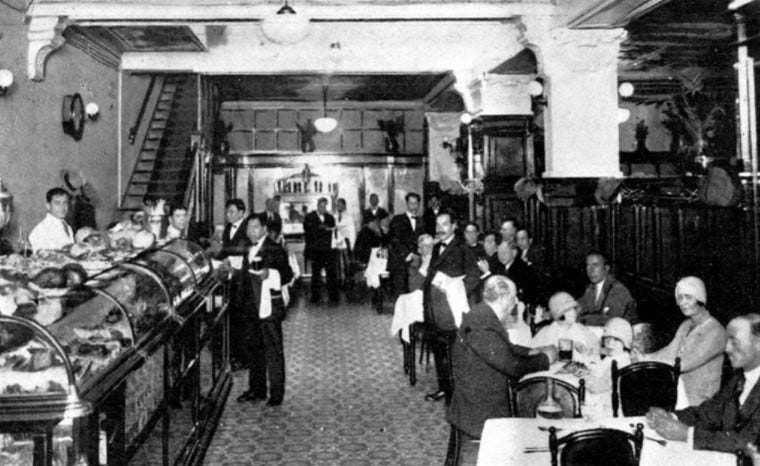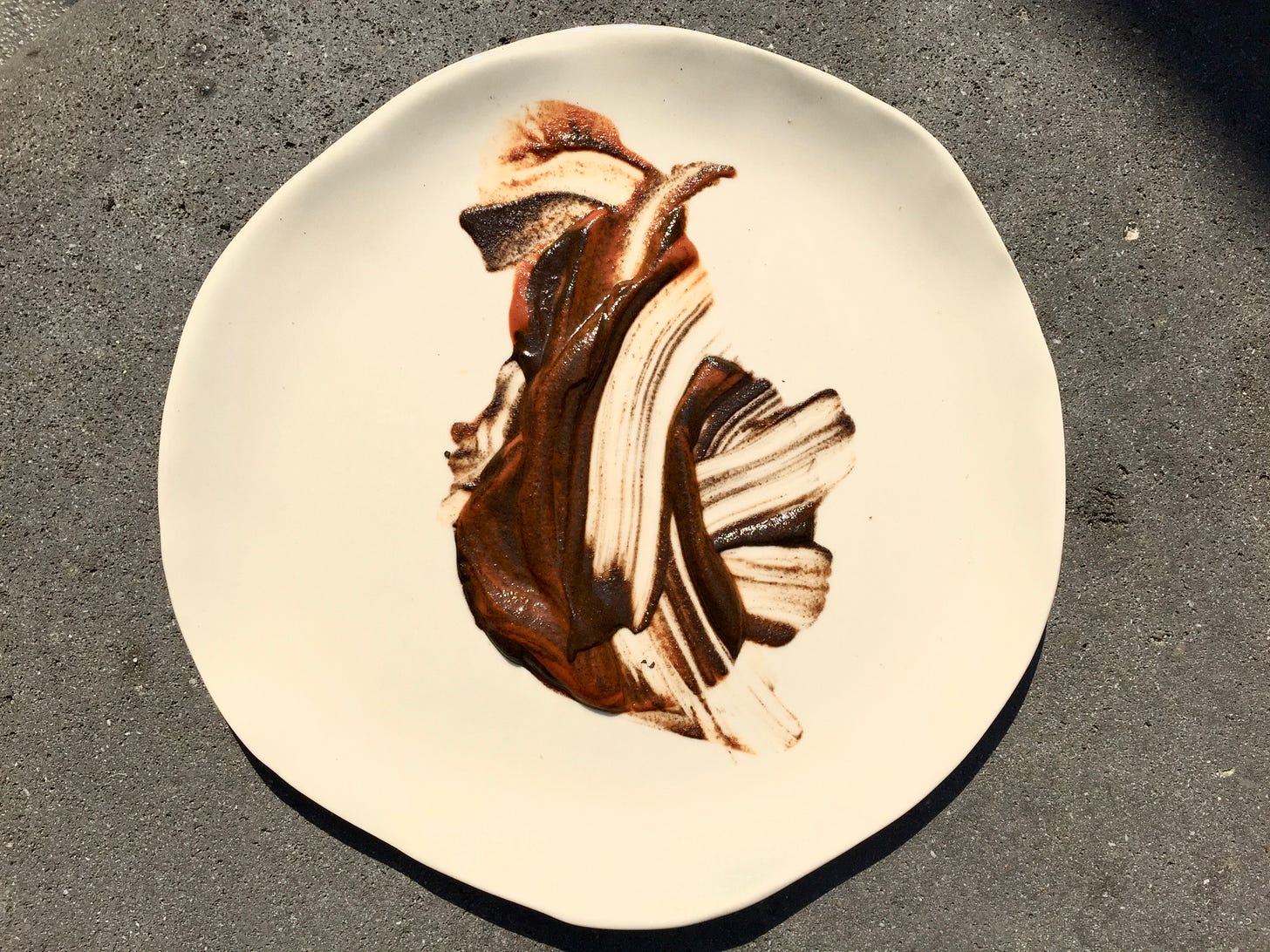(*También pueden encontrar la versión original —en español— del texto reproducido a continuación, aquí).
Mole is, at the same time, permanence and transformation. As long as the cazuela is turned on and the preparation is brought to a boil every so often, a mole can be reheated perpetually without spoiling, but also, without its flavors ceasing to change, to acquire character, to keep maturing. In the same way, my writing —since it was first splashed by this uroboric sauce— has not stopped spinning around its spiral, and being inevitably attracted by its centrifugal inertia towards the journey without end (or beginning) that entails the analysis of the Mexican idiosyncrasy, through its representative foods.
Here, I reproduce a translated version of the essay (published in the Revista de la Universidad Autónoma de México in April 2019) that began my particular journey as a food writer with mole (and, in a symbolic sense, with the study of the food of México, in general) which continued in this newsletter with an essay in three installments that I published during the pandemic, and, more recently, with a text that will soon be published in Spain, and that I hope to share with you in the near future.
La Madre, el Mole y Pujol
Microhistory of Mexican Cuisine
Mexican cuisine is a fleeting concept. We believe that we are clear about what it means and when we try to state it, words escape us. It is never convincing, fair or encompassing enough. Like the self-evolving, unattainable character of nature that Emerson analyzes in Circles (1841) and describes as a self-evolving circle, which, from a ring imperceptibly small, rushes on all sides outwards to new and larger circles, and that without end. It is no coincidence that the iconic dish of Mexico’s most famous restaurant —in the fine-dining sphere— has the same circular, evolving shape. I am referring to Pujol's mole madre. A dish composed of two different mole sauces plated in two concentric circles: a freshly made, red (or “coloradito”) mole in the center; and a black Oaxacan mole —reheated for almost six years— surrounding the first. The mother and the son. Wisdom and evolution. If the success of its chef, Enrique Olvera, could be summed up in one dish, it would be this one. If the history of Mexican cuisine could be told with a single dish, it would also be —not only this one— but all moles repeating themselves in a circle ad infinitum.
If we classify the ingredients of all the moles, just by repetition, we can decipher their primary components. But in addition, if we separate each one and trace its origin, it is also possible to distinguish the influence of other cultures on ours. There are dishes that, due to their origins, can lay bare the history of the peoples. Mole is a good example of that. We do not know when it began to be prepared, but we do know that by the time the conquistadores arrived in Mexico, it was already a ceremonial dish. In the Historia General de las Cosas de la Nueva España (1540-1585), Fray Bernardino de Sahagún describes “chili stews” or “chilmollis ” that were prepared with different chilies, tomatoes, pumpkin seeds, corn dough, roasted and grounded beans, hoja santa, epazote, avocado leaf, and unripe plums, and that were served in a casserole to accompany turkey, frogs, tadpoles, axolotls, fish, lobsters, shrimp, winged ants, maguey worms, wild mushrooms and quelites (endemic leaf greens).
In later versions of convents and Criollo homes, European and Asian ingredients began to be included in these stews. The text The moles. Pre-Hispanic Contributions by Cristina Barros recovers fragments of recipe books that exemplify this evolution: that of Dominga Guzmán (1750) with a pipián with sesame and peanuts; that of Fray Jerónimo de Pelayo (1780) with a manchamanteles that includes cumin; a clemole from the Recetario Novohispano (1791) with roasted sesame, coriander, cumin, garlic, cloves, pepper, cinnamon and ginger (here, we can start to see the relation to curry that Octavio Paz emphasized about in Vislumbres de la India, 1995); and another clemole in the Arte novísimo de la cocina (1872) where cocoa appears for the first time in a recipe.

So, how did we transitioned from ceremonial moles to tasting menu moles?
There are historical facts that led to this process. The idea of eating out is very old, it was first born as a necessity and it was then exalted as a pleasure, and although this transition of mindset is not particular to a time or a culture, the French concept of restaurant was the first to institutionalize it. The first restaurants were —literally— places to be “restored”.[i] Before this concept of wellness and that of the à-la-carte restaurant that the French exported to the world in the 19th century, two important transformations took place: the French Revolution and the Napoleonic era.
The pleasure of good eating had ceased to be a privilege reserved for the courtly elites, but the new gastronomic philosophy was not exactly built on ideals of equality. Eating at a restaurant became such a sophisticated activity, that its language became incomprehensible to most people. Two elements appeared then to help interpret this new narrative: menus and food critics. The first, facilitated a better dialogue between diners and the kitchen; the latter —ironically— made it more inaccesible and elitist. Characters such as Jean Anthelme Brillat-Savarin and Grimod de La Reynière became popular. In 1803, de La Reynière published the first L'Almanach des gourmands, an important work, considering its gastronomic-literary content, but which became the antecedent of a pernicious virus, that the restaurant industry still suffers from today: the guides, the stars, the lists, the “star-chefs”, and all those arbitrary and inequality-fostering recognition systems.
The arrival of the French restaurant model in Mexico also happened in the context of two key transformations: the Porfiriato and the Revolution. The ruling elite clearly favored the European over the indigenous. The restaurants and their language only served to further accentuate these class tensions. [ii] Shortly after, the Mexican Revolution broke out. But while in the social and political realm the country was divided, the opposite happened in the kitchens. If we open an old cookbook like the El cocinero mexicano, we can realize that in the field of cooking, before the concept of the french restaurant arrived in México, there was already a fusion cuisine that found its best expression in the convents. Chiles en nogada are an excellent example of this mestizaje.

After the insurgent movement, this parallel revolution kept developing itself, as groups of women home cooks —mostly led by Josefina Velázquez de León and Vicenta Torres Rubio— teamed up to produce a series of cookbooks, in which they expressed their personal vision of the nation, while maintaining an air of domestic respectability, says Jeffrey M. Pilcher in Qué Vivan los Tamales! This undertaking of the recollection of the culinary memory of women from all over the country, turned out to be the only truly effectively way to incorporate the plurality of México, and build a sense of community and identity among people (something that the actual Revolution failed at). This role of women in the culinary life of Mexico has never lost continuity, although, in the world of chefs and restaurants, its merits are mostly invisible.
In an interview published in Letras Libres [iii], Enrique Olvera talks about his creative influences in the 1980s and 1990s, he says: In Mexico there were no 'great chefs', if anything, there were great restaurants […] My references were what my mother cooked. My mom's handwritten recipe book. Which is strange because, by then, there already existed a few well-known figures —cooks, restaurateurs, book writers, television hosts, teachers, or, everything at the same time— like Josefina Velázquez de León, Patricia Quintana, Mónica Patiño, Alicia Gironella, Carmen Ramírez Degollado, and Carmen Ortuño, just to mention a few. In addition, the fact that he points out his mother's recipe book as his only culinary reference, says more than it seems to in the surface, because without intention, it unveils the lack of recognition to women’s cooking in the professional field, when it actually from it, that he himself has watered down his greatest ideas. That kind Mexican cuisine —made at homes, on the country, and on the streets— is the one that has never stopped evolving. It is old and wise, but, at the same time, it modern and inclusive. It is not prejudiced or snob. It takes advantage of what it has available, and is also not a stranger to modernity. It incorporates. It adds. It's like a glass of esquites with mayonnaise, lime, and powdered chili (not coincidentally, another iconic reinterpretation in Pujol’s menu).
In that same interview, Enrique identifies three key stages in his cooking: a first one influenced by the new Californian cuisine of Thomas Keller, another one of deconstruction of Mexican cuisine that followed the model of Ferran Adrià's El Bulli, and a third one of simplification motivated by René Redzepi from Noma. If we review a recent menu at Pujol, we can realize several things. First, as Dan Jurafsky ( The Language of Food , 2014) says, the trend indicates that “the more expensive [the restaurant], the fewer options one has”. In that sense, Pujol's is intermediate: six courses with three options each, only the first and fifth are fixed (the antojitos and the mole). It has this cult-like tendency to the figure of the chef/author who takes decisions for the diner, but it is relatively flexible. We can also identify the regional approach, not in a strict sense, but in that favors native ingredients: hairloom corns, chayote, ayocote, chiles, romeritos, quintoniles, miltomates, nopales, wild mushrooms... It is a mostly vegetarian menu, another quality that he takes from pre-Hispanic cuisine. We can also identify more personal things: reminiscences of the calamares en su tinta from his mother's recipe book in the octopus in habanero ink with ayocote and salsa veracruzana; or the molcajete sauce with chicatana ants that he tried in Cuquila, Oaxaca, mixed with Mexico’s favorite street snack in the tender corn with coffee mayonnaise and chicatana ants. [iv]
Jean-François Revel said that Mexican cuisine was not a product of art but of ethnology, he also said that international haute-cuisine was superior to all because the chefs who know it are men. [v] Those ideas that today sound archaic and ridiculous have actually not been completely eradicated. Women in restaurant kitchens are still seen in a secondary role, as spectators, aspirants, or sidekicks rather than true creators, when they are the ones carrying all the traditional wisdom. On the other hand, superfluous and ambiguous meanings are often given to adjectives such as authentic and sophisticated, when applied to food.
A woman who collects corn in the field, puts it to dry, shells it, separates it, boils it in the pot with the exact proportion of water and limestone, by smell and touch knows the cooking and resting times, cleans and rinses the corn between her fingers, takes it to the mill or grinds it on a metate, kneads it into a soft dough that she flattens with the palm of her hands until it forms a thin and even circle, that she unfolds in a single and precise movement over the comal without it wrinkling, and, after a couple of turns, explodes in a perfect circle: that is art. If we can give Olvera credit for anything, it is for convincing more people about it —including ourselves. But such a thing would not have happened without his mother's recipe book, without the unconditional support of his wife, and without the wisdom of millions of Mexican cocineras.
This is not about taking credit away from Olvera. What I want to say is that, the reality of the culinary world —like so many others— is that it still responds, dominantly, to patriarchal-minded system. And, that it took the figure of a man graduated from an elite Eastern cooking school to turn the world upside down for a Mexican dish. Pujol's mole madre is nothing, but a reflection of the times we live in, and if its value lies in anything, it is in that each bite of corn tortilla and hoja santa covered with mole —half old, half new— is, in reality, a tribute to the deep, country, indigenous, conventual, creole, European, Asian, Middle Eastern, revolutionary, street, domestic, and feminine cuisine: the mother of all moles.







